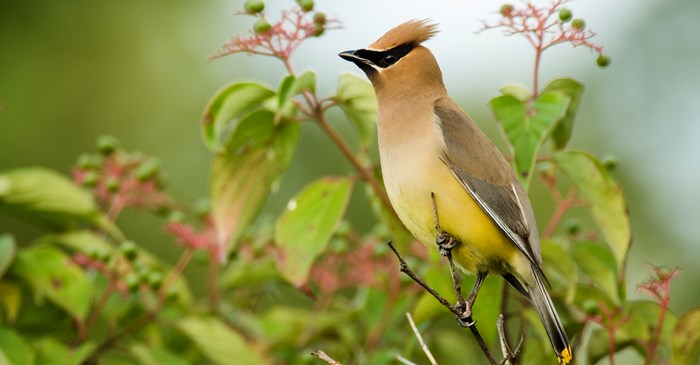The Cedar Waxwing is a bird of beauty. You might think Mother Nature consulted with a graphic designer, with their silky “airbrushed” tan feathers and a black mask that seamlessly ties into their sharp, black beak.
Their dark gray wingtips sport scarlet markings that, apparently, reminded someone of drips of red sealing wax. Researchers don’t know the purpose of these namesake red spots, but one theory is these may help them attract mates.
As a finishing touch, their dark gray tail feathers have bright yellow tips, as if they were dipped in paint. However, starting in the late 1960s, Cedar Waxwings with bright orange tail tips in place of the yellow began showing up in the northeastern U.S. and southwestern Canada. Scientists believe the transformation was caused by the red berry pigments of a honeysuckle species that was introduced in the area. That means if a Cedar Waxwing eats enough of these special berries while this feather is growing, the tip emerges as orange instead of yellow!
The Cedar Waxwing is found year-round in northern U.S. states. If you’re on the lookout for the Cedar Waxwing, you’re most likely to find them while hiking in the forest. During the summer months, you may see them flying over waterways catching bugs with their open beaks. Despite that, it is fruit that supplies much of the Cedar Waxwing's diet. In fact, they are one of the few North American songbird species that live on fruit for much of the year.
In the fall, the Cedar Waxwing gathers in social flocks to forage for berries and other remaining fruits on trees and shrubs. If fruit supplies run low, they will migrate. Depending on availability of food, they may reach far south places such as Florida or even Panama.
If you wish to attract Cedar Waxwings to your yard, landscaping is key. Plant native shrubs and trees that produce berries and fruit such as winterberry, crabapple, dogwood, mountain ash, honeysuckle, Russian olive, cedar, juniper, serviceberry and hawthorn. If you’re hoping for an up-close look at the feeder, fill it with a mix that includes plenty of fruit ingredients, such as Lyric Fruit and Nut Mix.
